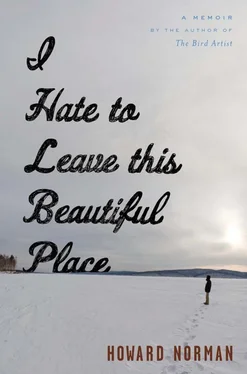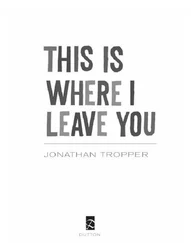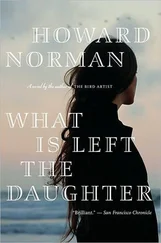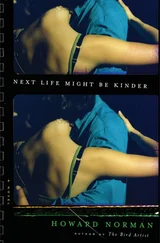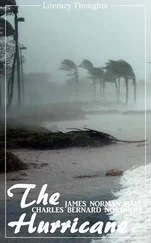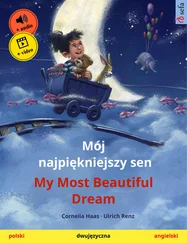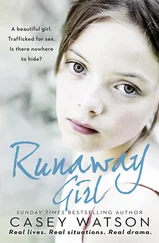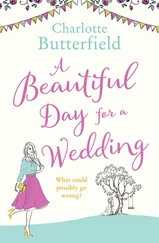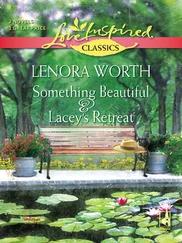This odd thing happened with television in Vermont. I can far better understand it now, but at the time it was working on an altogether perplexing level. Jane started to watch reruns of Law and Order —mornings, afternoons, nights. These dramatic procedurals provided background visuals and voices (which sometimes felt like voice-overs of our own life, because to hear what the characters were saying, our silence was required) on the second floor of the farmhouse. I’d come and go, taking in snippets of dialogue and becoming generally apprised of plots and able to recognize the principal actors so splendid at portraying sanctimonious and brilliantly analytical detectives and scolds. Years later, when discussing this, Jane said that she was working on hope, and her thinking was that if she relentlessly exposed herself to the sheer plentitude and commonality of murder, it might somehow serve to anesthetize the pain of an individual homicide and “make things a little better.” In episode after episode of Law and Order, the unifying reason for suspension of disbelief was that, with few exceptions, the murder was solved and the perpetrator brought to justice. Yet in messier real life outside of television, there had been the perverse miscarriage of justice in Reetika Vazirani’s taking the life of her son, so as to “save him from a terrible world,” a verbatim quote of the helter-skelter logic she advocated to herself more than once in her notebooks. Jane watched episodes of Law and Order for some time, until she realized that she’d begun to “retraumatize” herself, and so for the most part stopped.
But Jane wasn’t alone in trying to find some way to invest in the possibility of allegory helping out a little. Over the next six months, I watched at least thirty times the classic cinematic treatise on child murder, M, directed by Fritz Lang and starring Peter Lorre. (I had not thought much about this movie since I was twenty, living in Halifax, when Isador Sarovnik regaled me with stories of his friendship with Laszlo Lowenstein.) But my successive viewings of this German expressionist film only served to transfer the real-death images — for example, those in the police photographs taken in our dining room — to the cinematic depiction of child murder. Not much help there at all, really.
Emma had turned fifteen in April 2003. A wonderful pleasure to be with. She was a regular teenager, though I also knew her to have a big appetite for life and to be remarkably poised. Naturally, when the murder-suicide took place in July, that poise was shattered, but she got right to dealing with it. The morning after we received the news, she asked to go rowing on East Long Pond; I’d rented a cottage there for the summer. And that’s what we did. She took up the oars and rowed herself and me the mile or so circumference of the pond. And whether consciously or not, she rowed with fierce concentration and at a fast pace, her face flushed with exertion, her arm and leg muscles straining, and I mean without cease, until we returned to the dock. Once we had overturned the rowboat on land and begun to walk up the wooden steps of the cottage, she said, “I won’t develop the photographs I took of Jehan. But they should be developed. That little boy’s family should have them.”
I felt right then, and feel the same way now, that this seemed entirely consistent with Emma’s dignified comportment, and that it showed a lot of self-knowledge, too. I’d observed Emma at work in various darkrooms and could see she loved knowing her way around them, and that she had already given herself to a kind of parallel life in photography — that is, apart from school and the vexations and challenges of being a teenager. I can’t really say that it was at that age she’d started thinking of herself as a photographer, but I knew that for her photography was definitely a passion. Her photographs of Jehan had originally been a fifteen-year-old’s way of trying to entertain a two-year-old boy — they’d spent less than an hour together, only once, the day he and his mother came to discuss staying in our house — and all of a sudden the photographs had become memorial portraiture.
And so, driving home from East Long Pond, as we spoke a little more about the photographs — because she wanted to — it became evident to me that Emma knew how to protect herself, in the red-tinged light of a darkroom, from having to see a child’s innocent face float up in a tray of developer. “No way,” as she put it. “No way.” And I thought, My daughter’s going to be okay. In the end, I delivered the negatives to Andrew, one of Emma’s photographic mentors, whom she’d apprenticed to and who had encouraged her to attend a summer class at the Maine Media Workshops. I told Andrew, at Emma’s insistence, that after he’d developed the negatives, he should not leave the prints around his studio where Emma might see them. Andrew sent the photographs to Reetika Vazirani’s mother and stepfather, who never acknowledged receiving them.
It is important to say again that I scarcely knew her. I didn’t at the time and don’t now care to be informed about her biographical details. I’ve had quite enough of her life, which so violently intersected with my family’s. We were friendly, but not friends. I admired some of her writing and even published three of her poems in an issue of the literary journal Conjunctions that I edited.
For a month or so before she took up residence in our house in Washington, Jane had spoken with her on the telephone. My understanding is that Reetika Vazirani had called to ask about teaching jobs, but also indicated that most aspects of her life remained unresolved, including where she might live during the summer. Jane and I had been used to letting writers stay in the house. So it was characteristic of her empathy that Jane suggested Reetika Vazirani and her son Jehan might consider doing just that. No big deal, really. We were going to Vermont anyway, and it would be good to have someone look after things. For us it would be a mitzvah —the right thing to do. Personally, I had spoken with Reetika Vazirani only once before, at the Bread Loaf Writers’ Conference in Vermont, and the topic of discussion on that occasion had been restaurants in Middlebury. The second time we spoke was when she stopped by in Washington to discuss housesitting.
On that visit, I had no sense of her taking any measure of the house at all: we sat in the living room drinking tea while Jehan watched a children’s video upstairs in Emma’s room. After exchanging pleasantries, she said, “A lot of writers said you were away in the summer, and we met once, remember?” Perhaps skeptical, certainly a touch edgy, I said, “Oh, a lot of writers. Who? ” She reeled off a dozen or so names, and I thought: I don’t know any of them. The initial discomfort on my part may have been caused by the fact that she was so deftly able to suggest the sponsorship of a very loose-knit literary community. But the thing was, when she started in on her domestic travails, I didn’t grant much leeway. I felt that asking for a roof over her head was difficult enough without her having to test out various reasons. Besides, the most important reason was upstairs watching a video in my daughter’s room.
How could I know? How could I know that the simplicity of our verbal contract — while living in our house you take care of it — might obfuscate future malevolence? Hindsight, of course, is powerfully suggestive and self-indicting, but cannot change what happened. Yet it has often occurred to me that had I let this weary-looking, jittery, and singularly accomplished woman with the lovely smile, whose intelligence I was, on the surface, beginning to enjoy, indulge in an hour or so of what I later understood to be a fugue state of exhaustion, fuming anger, self-pity, emotional claustrophobia, and God knows what else, I most likely would not have, at least in so perfunctory a manner, muted my protective instincts. I would have heard something alarming. In one breath I say, How could I know? and in the next breath say, I should have known.
Читать дальше
